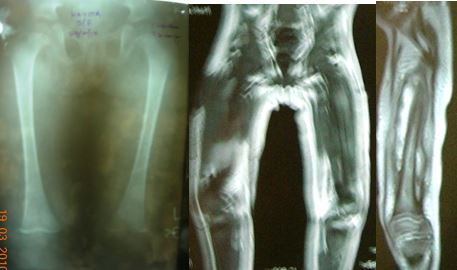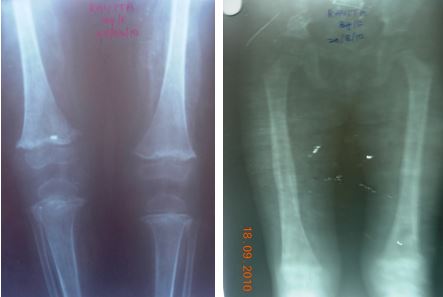Ratanchu from Thailand reviewed 28 cases of scurvy in children over a 7-year period (1995-2002) and noted prolonged consumption of heated milk and inadequate intake of vegetables and fruits as the risk factors for the development of scurvy [7].
Epidemic scurvy has been reported among refugee populations with incidence of 5% in women and 12% of men, and in those older than 65 years, this proportion increased to 15% of women and 20% of men [8].
Data from the Third National Health and Nutrition Examination Survey (NHANES III) that assessed the prevalence of vitamin C deficiency in the United States among a sample of 15,769 children and adults (12-74 y) found that 14% of males and 10% of females were vitamin C deficient [9].
Scurvy can occur at any age. Most cases of Scurvy occur when the child is aged between 6 to 24 months. Clinical manifestations develop after an infant has lacked Vitamin C for 6 -10 months. Hence, Scurvy is uncommon in neonates as human breast milk contains sufficient Vitamin C, provided the mother has adequate intake. Vitamin C is destroyed by the process of pasteurization, so babies fed with ordinary bottled milk sometimes suffer from Scurvy if they are not provided with adequate Vitamin C supplements. Virtually all commercially available baby formulas contain added Vitamin C for this reason, but heat and storage destroy Vitamin C [10].
Vitamin C deficiency leads to defective collagen synthesis resulting in defective dentine formation, gum bleeding, and loss of teeth. Hemorrhaging is a hallmark feature of Scurvy and can occur in any organ. Hair follicles are one of the common sites of cutaneous bleeding. There are reports of a purpuric rash on trunk and legs which responded to Vitamin C supplementation [11].
Hemorrhages of the gums usually involve the tissue around the upper incisors, which have a bluish-purple hue and spongy feel. Gum hemorrhage occurs only if teeth have erupted. Petechial hemorrhage of the skin and mucous membranes can occur. Rarely, hematuria, hematochezia, and malena are noted.
Proptosis of the eyeball secondary to orbital hemorrhage can occur. Besides being essential for collagen synthesis, ascorbic acid is important for biosynthesis of carnitine and neurotransmitters and in hematopoiesis by promoting iron absorption. Risk factors for development of scurvy include male, having a low dietary intake of vitamin C, not taking vitamin supplements, and smoking [12].
Initial symptoms of a child with scurvyare nonspecific and include loss of appetite, peevishness (ill-tempered), poor weight gain, diarrhea, tachypnoea, fever. Specific symptoms include irritability, pain and tenderness of the legs, pseudoparalysis,
swelling over the long bones and hemorrhage. Costochondral beading or scorbutic rosary is a common finding. The scorbutic rosary is distinguished from rickety rosary (which is knobby and nodular) by being more angular and having a step-off at the costochondral junction. The sternum is typically depressed.
Although, hyperkeratosis, corkscrew hair, and sicca syndrome are typically features of adult scurvy and are rarely seen in infantile scurvy, Mc Kenna reported an infant with these features of adult scurvy showing diffuse, nonscarring scalp alopecia with radiologic features of scurvy was reported in 2008 [13].
Bony involvement is typical for infantile scurvy, which occurs at the junction of the diaphysis end and the growth cartilage. Osteoblasts fail to form osteoid (bone matrix), resulting in cessation of endochondral bone formation, but normal calcification of the growth cartilage continues, leading to thickening of the growth plate. The typical invasion of the growth cartilage by the capillaries does not occur.
Preexisting bone becomes brittle and undergoes resorption at a normal rate, resulting in microscopic fractures of the spicules between the shaft and calcified cartilage. With these fractures, the periosteum becomes loosened, resulting in the classic subperiosteal hemorrhage at the ends of the long bones. Intra-articular hemorrhage is rare because the periosteal attachment to the growth plate is very firm [14].
Subperiosteal hemorrhage is a typical finding of infantile scurvy, which is often palpable and tender in the acute phase causing excruciating pain and is seen at lower ends of the femur and tibia which are the most frequently involved sites.
Plasma ascorbic acid level may help in establishing the diagnosis, but the best confirmation of the diagnosis remains its resolution following vitamin C administration. Plasma ascorbic acid level tends to reflect the recent dietary intake rather than the actual tissue levels of vitamin C. Signs of scurvy can occur with low-normal serum levels of vitamin C.
Fasting serum ascorbic acid level greater than 0.6 mg/dl rules out scurvy. Serum ascorbic acid levels of less than 0.2 mg/dl are deficient and Scurvy occurs at levels less than 0.1 mg/dl. The earliest radiologic manifestations are seen at growth cartilage-shaft junction of bones with rapid growth like distal ends of radius or femur, where fuzziness of the lateral aspects of the cortices is present with slight rarefaction of the neighboring cancellous bone.
As the disease progresses, the cortex becomes thin and the trabecular structure of the medulla atrophies and develops a ground-glass appearance. The zone of provisional calcification becomes dense and widened, and this zone is referred to as the white line of Fränkel. The epiphysis also shows cortical thinning and the ground-glass appearance.




